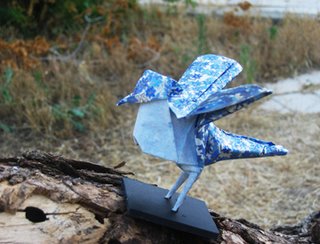Paper fans are a famous exception to this rule. Partly this is because the visible structure is dominated by those long, strong, widening spans. But look at the difference between these two fans--the second of which hides the cut edge in a mountain fold. It is manifestly less alive, less free. One wants the end of those firm spans to have something that opens into, is as gentle as----the air.

I’ve noticed, following this line of thought, that featheriness (and not just in fan tails) is nicely expressed in paper by a cut edge, the paper’s flimsiness evidently serving as a nice stand-in for a feather’s quasi-substantiality.

And here’s an old model, the Flitting Bird, where(as my young friend Yuval Atlas once observed) if you don’t look straight at them, the wing-tips with their cut edge seem to be in motion.

So: are there any other rightful uses out there for the Cut Edge?
FIRST POST
This blog has to start someplace; so it will start here. Don’t worry, pretty soon it will seem like I've been around forever.
For those who absolutely need them--links to previous scribblings on origami, all pretty much covering the same ground, are here:
ARTICLES
Folding Female Faces (also in: The Origami Forum, 2005)
Taxonomy of Curved Folding (Letter to David Lister, 2005)
Versatility of Origami (2005)
Sculptural Origami Exhibit at the Holon Design Gallery (BOS article, 2005)
An Origami Minimalism (2004) ; written for the 1st Israeli Origami Convention Book
EXHIBITS
2005: Masters of Origami
2004: Holon Exhibit of Sculptural Origami